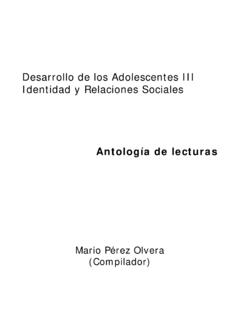Transcription of The efficacy of single-session motivational …
1 RESEARCH REPORT 2004 Society for the Study of Addiction Addiction, 99 , 39 52 Blackwell Science, Ltd Oxford, UK ADDA ddiction 1360-0443 2003 Society for the Study of Addiction to Alcohol and Other Drugs 98 Original Article Jim McCambridge & John StrangEfficacy of single -session motiva-tional interviewing Correspondence to: Jim McCambridge National Addiction Centre (The Maudsley/Institute of Psychiatry) Addiction Sciences Building 4 Windsor Walk Denmark Hill London SE5 8AF UKE-mail: 2 August 2002; initial review completed 16 September 2002; final version accepted 4 July 2003 RESEARCH REPORT The efficacy of single -session motivational interviewing in reducing drug consumption and perceptions of drug-related risk and harm among young people: results from a multi-site cluster randomized trial Jim McCambridge & John Strang National Addiction Centre (The Maudsley/Institute of Psychiatry), London, UK ABSTRACT Aim To test whether a single session of motivational interviewing (discussingalcohol, tobacco and illicit drug use) would lead successfully to reduction in useof these drugs or in perceptions of drug-related risk and harm among youngpeople.
2 Design Cluster randomized trial, allocating 200 young people in the naturalgroups in which they were recruited to either motivational interviewing( n = 105) or non-intervention education-as-usual control condition ( n = 95). Setting Ten further education colleges across inner London. Participants Two hundred young people (age range 16 20 years) currentlyusing illegal drugs, with whom contact was established through peers trainedfor the project. Intervention The intervention was adapted from the literature on motivationalinterviewing in the form of a 1-hour single -session face-to-face interview struc-tured by a series of topics. Measurements Changes in self-reported cigarette, alcohol, cannabis and otherdrug use and in a range of drug-specific perceptions and other indicators of riskand harm. Measurement at recruitment and follow-up interview 3 monthslater.
3 Findings A good follow-up rate ( ; 179 of 200) was achieved. In compar-ison to the control group, those randomized to motivational interviewingreduced their of use of cigarettes, alcohol and cannabis, mainly through mod-eration of ongoing drug use rather than cessation. Effect sizes were ( ), ( ) and ( ) for reductions in the use of ciga-rettes, alcohol and cannabis, respectively. For both alcohol and cannabis, theeffect was greater among heavier users of these drugs and among heavier cig-arette smokers. The reduced cannabis use effect was also greater among youthusually considered vulnerable or high-risk according to other criteria. Changewas also evident in various indicators of risk and harm, but not as widely as thechanges in drug consumption. Conclusions This study provides the first substantial evidence of non-treatmentbenefit to be derived among young people involved in illegal drug use in receiptof motivational interviewing.
4 The targeting of multiple drug use in a genericfashion among young people has also been supported. KEYWORDS: alcohol, brief intervention, cannabis, cigarette smoking, drugs, motivational interviewing, young people. 2004 Society for the Study of Addiction Addiction, 99 , 39 52 40 Jim McCambridge & John Strang INTRODUCTION Conceptualization of the intervention problem Drug use among young people provides numerous tar-gets for intervention. Worrying recent trends in the prev-alence of cigarette smoking, levels of drinking amongyoung people, the emergence of new patterns of binge-drinking and rising levels of illegal drug use (Boreham &Shaw 2001; Ramsey et al . 2001; Walker et al . 2001) areall features of recent experience in Britain and capacity to influence young people s choices andbehaviours with effective early intervention is extremelylimited, and while the application of interventions to newtargets has been recommended (ACMD 1993), this chal-lenge remains to be benefits have been associated with some pri-mary prevention programmes elsewhere, the results ofmost drug interventions targeting young people are dis-appointing (Botvin et al.)
5 1995; Foxcroft, Lister-Sharp &Lowe 1997; Tobler 1997; White & Pitts 1998). Even witheffective primary prevention interventions, many youngpeople will make decisions to initiate and to continue touse drugs. Approaches aimed at the secondary preven-tion of drug use among young people have hithertoreceived less prevention concepts and interventions tar-geting drug use have developed significantly since the1980s to assist HIV prevention (ACMD 1988; Newcombe1992). The adoption of a broader public health approachconcerned with risk, rather than a clinical focusrestricted to consumption or the treatment of depen-dence, has been extremely influential among adults(Stimson 1995; Strang 1998). Prevention needs to be re-conceptualized to explore overlooked opportunities forintervention (Strang 1994).
6 The ACMD has recom-mended intervention earlier in drug-using careers tosecure diversion away from high risk (ACMD 1993). Forexample, among the many new possibilities for interven-tion objectives, the prevention of progression to newhigher-risk routes of administration has been identified(Hunt et al . 1999).Secondary prevention of drug use among young peo-ple has been considered most widely in relation to vul-nerable groups such as the homeless, those involved inprostitution or children in public sector care (UpdatedDrug Strategy 2002). In such groups, elevated risk ofserious drug problems is believed to require dedicated tar-geting. The basis of these targeting decisions has, how-ever, received relatively scant attention in the is, however, a firm epidemiological basis to thetargeting of young drug users more broadly.
7 Adolescentdrug use in the general population has long been knownto involve cumulative processes (Kandel et al . 1986).Young people using illegal drugs are also more likely touse legal drugs (Boreham & Shaw 2001; Measham et al .2001) and more heavily (Sutherland & Willner 1998;Ramsey & Partridge 1999). Involvement in drug use atearlier ages is also associated with heightened risk of laterdrug problems and psychosocial difficulties more gener-ally (Anthony & Petronis 1995; Fergusson & Horwood2000).Secondary prevention objectives among young peoplemay either be specific to risk behaviours ( reduction incurrent drug consumption, prevention of injecting), or generic (addressing the totality of a young person s rela-tionship to drugs). Generic interventions need to takeaccount of the life context of drug use.
8 Targeting youngpeople at early stages of drug-using careers with a view toreducing consumption, preventing further involvementin drug use, minimizing problems or facilitating informedchoice about the personal consequences of drug use areunder-developed areas of harms often only become evident a dis-tance in time from the originating drug use events(Strang 1992; Heather 1995a). As such, a focus on pos-sibly distant harms may be considered to lack personalrelevance or salience. Specific risk behaviours, on theother hand, may be relatively amenable to interventiontargeting (Strang 1993). Risk may also be conceptualizedas being inherent in drug consumption or other potentialsource of harm (Institute of Medicine 1996). Amongthose considered to be at-risk, it should not be assumedthat evidence of harm is absent, and assessment of boththe presence and severity of specific risks and harms isnecessary.
9 In practice, measurement of risk and harmmay be difficult, and surrogate indicators have been rec-ommended as an alternative (Lenton & single 1998). Fol-lowing Kandel et al . (1986), short-term modification inrisk may be conceptualized as having the potential toalter the course of subsequent drug use. Assessment ofshort-term intervention effect is the logical first step inthe evaluation of intervention efficacy. motivational interviewing as an intervention with young people who use drugs Encouraging evidence exists on the capacity of opportu-nistic brief interventions to influence smoking and drink-ing among adults (Russell et al . 1979; Heather 1995b;WHO Brief Intervention Study Group 1996; Wetter et al .1998). motivational interviewing (MI) has been devel-oped as an influential adult intervention approach (Miller& Rollnick 1991, 2002), and adapted to other healthbehaviours about which the individual seeks to promote reflection on drug use and its per-sonal consequences in the context of the values and goals Efficacy of single -session motivational interviewing 41 2004 Society for the Study of Addiction Addiction, 99 , 39 52 of the individual.
10 MI is not compatible with a simple anddirect communication of a public policy objective, andthus occupies a potentially complex position in relation toany specific public policy objective, where there is a con-flict between the values and goals of the individual andthe aspirations of public policy. Such conflict may be min-imized where the goals of intervention are definedbroadly in terms of harm minimization and where inter-vention objectives are (1991) and Lawendowski (1998) consider MI tobe particularly attractive to young people preciselybecause it is non-confrontational and does not imposespecific outcomes. Minimization of resistance is central toMI. In relation to young people s drug use, it may be alltoo easy to try too hard to persuade and thereby negateany potential beneficial effect by invoking an intervention which helps young people to con-sider risk may not reduce drug consumption, but maynevertheless be influential other possible measurablebenefits involve reduction of harm or recent years the first applications of MI with youngpeople have been reported.











